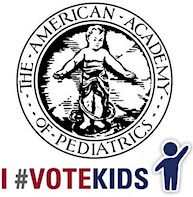Children should hold cellphones away from bodies, use speaker phone or send text messages, and avoid calls in cars, elevators, trains and buses, says the American Academy of Pediatrics.
 The AAP, based in Elk Grove, Ill., the nation’s largest group of children’s doctors with 64,000 members, released on Sept. 26 a set of recommendations for cellphone and wireless use.
The AAP, based in Elk Grove, Ill., the nation’s largest group of children’s doctors with 64,000 members, released on Sept. 26 a set of recommendations for cellphone and wireless use.
It cited the U.S. National Toxicology Program study that found “exposure to wireless radiation significantly increase the prevalence of highly malignant heart and brain cancers in rodents.”
AAP Recommendations for Children:
--Use text messaging when possible, and use cell phones in speaker mode or with the use of hands-free kits.
--When talking on the cell phone, try holding it an inch or more away from your head.
--Make only short or essential calls on cell phones.
--Avoid carrying your phone against the body like in a pocket, sock, or bra. Cell phone manufacturers can't guarantee that the amount of radiation you're absorbing will be at a safe level.
Beware of Cellphone “Distraction”
--Exercise caution when using a phone or texting while walking or performing other activities. Distracted walking injuries are also on the rise.
--If you plan to watch a movie on your device, download it first, then switch to airplane mode while you watch in order to avoid unnecessary radiation exposure.
--Keep an eye on your signal strength (i.e. how many bars you have). The weaker your cell signal, the harder your phone has to work and the more radiation it gives off. It's better to wait until you have a stronger signal before using your device.
--Avoid making calls in cars, elevators, trains, and buses. The cell phone works harder to get a signal through metal, so the power level increases.
--"Even though the cell phone manual contains specific instructions that say do not carry the phone next to the body, the US government does not publicize this information nor mandate companies inform the public, leaving most people unaware of potential hazards, unwittingly allowing their young children to play with them like toys," stated Devra Davis MPH, Ph.D., president of the Environmental Health Trust pointing to the Berkeley Cell Phone Right To Know Ordinance being challenged in court this month.
Cellphones: “Major Public Health Concern”
Ronald Melnick, Ph.D., NIH toxicologist who led the NPT study, said, "The findings of brain tumors and malignant schwann cell tumors of the heart in the NTP study, as well as DNA damage in brain cells, present a major public health concern because these occurred in the same types of cells that have been reported to develop into tumors in epidemiological studies of adult cell phone users.”
 The cancer risks may be greater for children “because of greater penetration and absorption of cell phone radiation in the brains of children and because the developing nervous system of children is more susceptible to tissue-damaging agents,” he said.
The cancer risks may be greater for children “because of greater penetration and absorption of cell phone radiation in the brains of children and because the developing nervous system of children is more susceptible to tissue-damaging agents,” he said.
“Based on this new information, regulatory agencies need to make strong recommendations for consumers to take precautionary measures and avoid close contact with their cell phones, and especially limit or avoid use of cell phones by children."
The AAP has updated its Healthy Children Webpage on Cell Phones entitled Cell Phone Radiation & Children's Health: What Parents Need to Know. The webpage reiterated children's unique vulnerability to cell phone radiation stating, "Another problem is that the cell phone radiation test used by the FCC is based on the devices' possible effect on large adults—not children. Children's skulls are thinner and can absorb more radiation."


 Lo Isidro, senior director at Real Chemistry with more than a decade of strategic communications and PA experience, has joined Narrative Strategies.
Lo Isidro, senior director at Real Chemistry with more than a decade of strategic communications and PA experience, has joined Narrative Strategies. Nelson Fernandez, former North American chair of APCO Worldwide and managing director of Burson-Marsteller, has joined Volunteers in Medicine Berkshires as director of communications and PA.
Nelson Fernandez, former North American chair of APCO Worldwide and managing director of Burson-Marsteller, has joined Volunteers in Medicine Berkshires as director of communications and PA. Lilit Bargar, who was most recently an EVP in the healthcare practice at Weber Shandwick, comes on board at GCI Health as EVP, corporate practice lead.
Lilit Bargar, who was most recently an EVP in the healthcare practice at Weber Shandwick, comes on board at GCI Health as EVP, corporate practice lead.
 Five ways that successful thought leaders are made.
Five ways that successful thought leaders are made.


 Have a comment? Send it to
Have a comment? Send it to 
No comments have been submitted for this story yet.